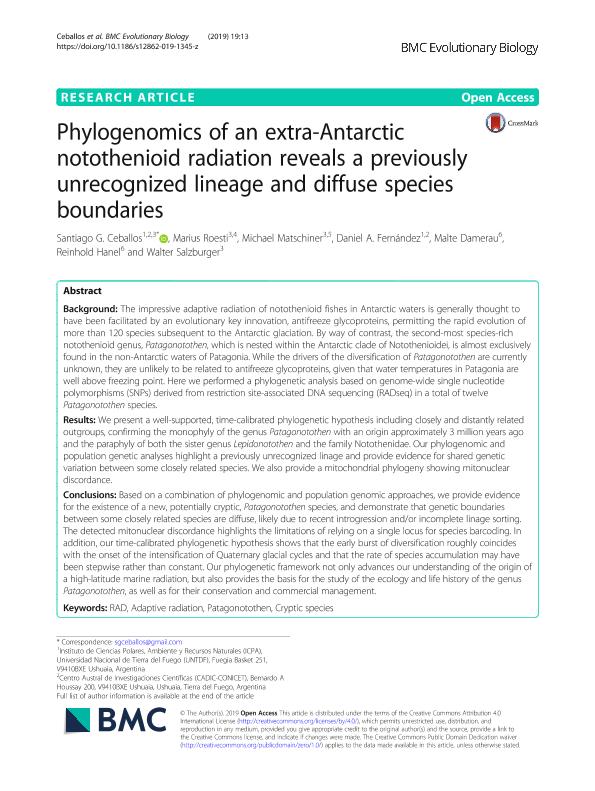Mostrar el registro sencillo del ítem
dc.contributor.author
Ceballos, Santiago Guillermo

dc.contributor.author
Roesti, Marius
dc.contributor.author
Matschiner, Michael
dc.contributor.author
Fernandez, Daniel Alfredo

dc.contributor.author
Damerau, Malte
dc.contributor.author
Hanel, Reinhold
dc.contributor.author
Salzburger, Walter
dc.date.available
2020-10-20T20:05:07Z
dc.date.issued
2019-01
dc.identifier.citation
Ceballos, Santiago Guillermo; Roesti, Marius; Matschiner, Michael; Fernandez, Daniel Alfredo; Damerau, Malte; et al.; Phylogenomics of an extra-Antarctic notothenioid radiation reveals a previously unrecognized lineage and diffuse species boundaries; BioMed Central; BMC Evolutionary Biology; 19; 1; 1-2019; 1-14
dc.identifier.issn
1471-2148
dc.identifier.uri
http://hdl.handle.net/11336/116193
dc.description.abstract
Background: The impressive adaptive radiation of notothenioid fishes in Antarctic waters is generally thought to have been facilitated by an evolutionary key innovation, antifreeze glycoproteins, permitting the rapid evolution of more than 120 species subsequent to the Antarctic glaciation. By way of contrast, the second-most species-rich notothenioid genus, Patagonotothen, which is nested within the Antarctic clade of Notothenioidei, is almost exclusively found in the non-Antarctic waters of Patagonia. While the drivers of the diversification of Patagonotothen are currently unknown, they are unlikely to be related to antifreeze glycoproteins, given that water temperatures in Patagonia are well above freezing point. Here we performed a phylogenetic analysis based on genome-wide single nucleotide polymorphisms (SNPs) derived from restriction site-associated DNA sequencing (RADseq) in a total of twelve Patagonotothen species. Results: We present a well-supported, time-calibrated phylogenetic hypothesis including closely and distantly related outgroups, confirming the monophyly of the genus Patagonotothen with an origin approximately 3 million years ago and the paraphyly of both the sister genus Lepidonotothen and the family Notothenidae. Our phylogenomic and population genetic analyses highlight a previously unrecognized linage and provide evidence for shared genetic variation between some closely related species. We also provide a mitochondrial phylogeny showing mitonuclear discordance. Conclusions: Based on a combination of phylogenomic and population genomic approaches, we provide evidence for the existence of a new, potentially cryptic, Patagonotothen species, and demonstrate that genetic boundaries between some closely related species are diffuse, likely due to recent introgression and/or incomplete linage sorting. The detected mitonuclear discordance highlights the limitations of relying on a single locus for species barcoding. In addition, our time-calibrated phylogenetic hypothesis shows that the early burst of diversification roughly coincides with the onset of the intensification of Quaternary glacial cycles and that the rate of species accumulation may have been stepwise rather than constant. Our phylogenetic framework not only advances our understanding of the origin of a high-latitude marine radiation, but also provides the basis for the study of the ecology and life history of the genus Patagonotothen, as well as for their conservation and commercial management.
dc.format
application/pdf
dc.language.iso
eng
dc.publisher
BioMed Central

dc.rights
info:eu-repo/semantics/openAccess
dc.rights.uri
https://creativecommons.org/licenses/by/2.5/ar/
dc.subject
ADAPTIVE RADIATION
dc.subject
CRYPTIC SPECIES
dc.subject
PATAGONOTOTHEN
dc.subject
RAD
dc.subject.classification
Genética y Herencia

dc.subject.classification
Ciencias Biológicas

dc.subject.classification
CIENCIAS NATURALES Y EXACTAS

dc.title
Phylogenomics of an extra-Antarctic notothenioid radiation reveals a previously unrecognized lineage and diffuse species boundaries
dc.type
info:eu-repo/semantics/article
dc.type
info:ar-repo/semantics/artículo
dc.type
info:eu-repo/semantics/publishedVersion
dc.date.updated
2020-04-24T18:01:00Z
dc.journal.volume
19
dc.journal.number
1
dc.journal.pagination
1-14
dc.journal.pais
Reino Unido

dc.description.fil
Fil: Ceballos, Santiago Guillermo. Consejo Nacional de Investigaciones Científicas y Técnicas. Centro Austral de Investigaciones Científicas; Argentina. Universidad Nacional de Tierra del Fuego; Argentina
dc.description.fil
Fil: Roesti, Marius. University of Basel,; Suiza. University of British Columbia; Canadá
dc.description.fil
Fil: Matschiner, Michael. University of Basel,; Suiza. University of Oslo; Noruega
dc.description.fil
Fil: Fernandez, Daniel Alfredo. Consejo Nacional de Investigaciones Científicas y Técnicas. Centro Austral de Investigaciones Científicas; Argentina. Universidad Nacional de Tierra del Fuego; Argentina
dc.description.fil
Fil: Damerau, Malte. Johann Heinrich von Thünen-Institut
; Alemania
dc.description.fil
Fil: Hanel, Reinhold. Johann Heinrich von Thünen-Institut
; Alemania
dc.description.fil
Fil: Salzburger, Walter. University of Basel,; Suiza
dc.journal.title
BMC Evolutionary Biology

dc.relation.alternativeid
info:eu-repo/semantics/altIdentifier/doi/http://dx.doi.org/10.1186/s12862-019-1345-z
dc.relation.alternativeid
info:eu-repo/semantics/altIdentifier/url/https://bmcevolbiol.biomedcentral.com/articles/10.1186/s12862-019-1345-z
Archivos asociados
